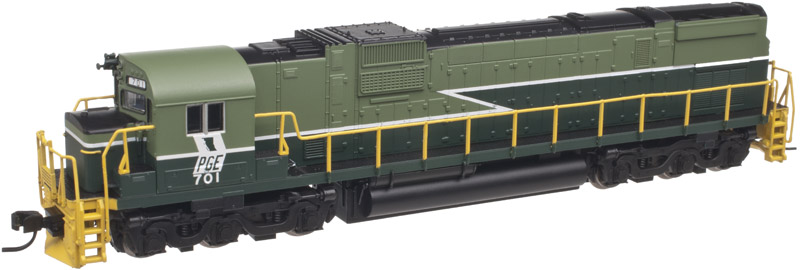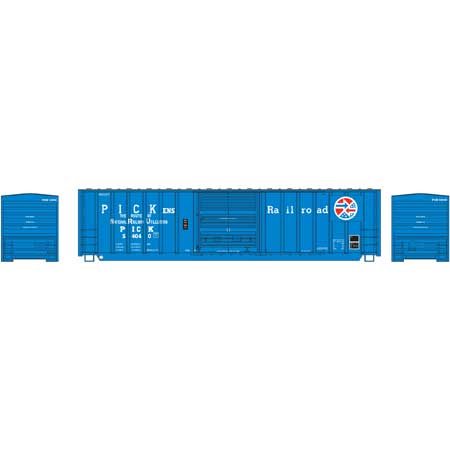Model Information: The Atlas Alco C-628 and C-630 share the same internal mechanisms and have very similar shells. They were introduced in 2004 and are typical modern Atlas locomotives. The mechanisms feature a split-frame design, blackened low-profile wheels LED lighting, and Accumate couplers.
The engines run smoothly and quietly and can easily pull 30 or more cars on an even grade. The shell detail is quite good including 'F' and 'R' indicators for normal operating direction.
The engines run smoothly and quietly and can easily pull 30 or more cars on an even grade. The shell detail is quite good including 'F' and 'R' indicators for normal operating direction.
Prototype History: The ALCO Century 630 was a six-axle, 3,000 hp (2.2 MW) diesel-electric locomotive built between 1965 and 1967. It used the ALCO 251 prime mover. 77 were built: 3 for Atlantic Coast Line Railroad, 4 for Chesapeake and Ohio Railway, 8 for Louisville and Nashville Railroad, 10 (with high noses) for Norfolk and Western Railway, 15 for Pennsylvania Railroad, 12 for the Reading Company, 15 for Southern Pacific Railroad and 10 for Union Pacific Railroad.
Montreal Locomotive Works produced a C-630M variant of the C-630, with 4 for British Columbia Railway, 8 for Canadian Pacific Railway and 44 for Canadian National. MLW M-630s were built by Montreal Locomotive Works from 1969 to 1973: 29 for CPR, 26 for BCR, and 20 for Ferrocarriles Nacional de Mexico (N de M). Eight of the BCR locomotives were designated M-630(W) and were built with a wide-nosed cab, known as the "Canadian" or "safety" cab. The latter two models, along with the nearly identical MLW M-636, had more in common with the ALCO C-636 than the C-630, and all MLW versions rode on high-adhesion trucks cast by Dofasco.
In January 1975, four Chesapeake and Ohio Railway locomotives were sold to Robe River Iron Associates in the Pilbara region of Western Australia. One was destroyed in an accident in February 1979, with the remaining three rebuilt by A Goninan & Co, Perth as CM40-8s in the early 1990s.
Three intact ALCO C-630s exist, Norfolk and Western 1135 at the Virginia Museum of transportation in Roanoke, Virginia. Reading 5308 at the Reading Company Technical and Historical Society in Hamburg, Pennsylvania. Union Pacific 2907 at the Arkansas Railroad Museum in Pine Bluff, Arkansas. Several M-630s exist. One is owned by the Western New York and Pennsylvania Railroad (WNYP), and two by Vintage Locomotive. CP M-630 #4563 is in operational condition at Exporail in St. Constant, Quebec. WNYP also has an MLW C-630M bought from the Arkansas and Missouri Railroad.
From Wikipedia
Montreal Locomotive Works produced a C-630M variant of the C-630, with 4 for British Columbia Railway, 8 for Canadian Pacific Railway and 44 for Canadian National. MLW M-630s were built by Montreal Locomotive Works from 1969 to 1973: 29 for CPR, 26 for BCR, and 20 for Ferrocarriles Nacional de Mexico (N de M). Eight of the BCR locomotives were designated M-630(W) and were built with a wide-nosed cab, known as the "Canadian" or "safety" cab. The latter two models, along with the nearly identical MLW M-636, had more in common with the ALCO C-636 than the C-630, and all MLW versions rode on high-adhesion trucks cast by Dofasco.
In January 1975, four Chesapeake and Ohio Railway locomotives were sold to Robe River Iron Associates in the Pilbara region of Western Australia. One was destroyed in an accident in February 1979, with the remaining three rebuilt by A Goninan & Co, Perth as CM40-8s in the early 1990s.
Three intact ALCO C-630s exist, Norfolk and Western 1135 at the Virginia Museum of transportation in Roanoke, Virginia. Reading 5308 at the Reading Company Technical and Historical Society in Hamburg, Pennsylvania. Union Pacific 2907 at the Arkansas Railroad Museum in Pine Bluff, Arkansas. Several M-630s exist. One is owned by the Western New York and Pennsylvania Railroad (WNYP), and two by Vintage Locomotive. CP M-630 #4563 is in operational condition at Exporail in St. Constant, Quebec. WNYP also has an MLW C-630M bought from the Arkansas and Missouri Railroad.
From Wikipedia
Road Name History: PGE launched in 1912 with a 12 mile line from North Vancouver, British Columbia to Horseshoe Bay where they picked up another 30 mile line reaching a point just north of Squamish. Six years later, the Province of British Columbia bought the railroad. By 1921, they had built north as far as Quesnel but that was it for the next 31 years. The south end of the line was abandoned in 1928.
In 1951, the Province pushed construction of the PGE north to Prince George in central B.C. and a connection with a Canadian National transcon line. This was the first physical connection with the North American rail network. Prior to that, interchange required car barges. In 1956, a rail link was finally completed to CN and CP in North Vancouver, finally closing the loop. In 1958, lines were built north from Prince George to Dawson Creek (and another CN connection.) In 1971, northward construction resumed to Fort St. John and finally Fort Nelson. This brought the mileage to 1,372 (putting it between Lehigh Valley and Iowa Chicago & Eastern in relative size.) The following year, 1972, the Pacific Great Eastern became the British Columbia Railway.
In 1951, the Province pushed construction of the PGE north to Prince George in central B.C. and a connection with a Canadian National transcon line. This was the first physical connection with the North American rail network. Prior to that, interchange required car barges. In 1956, a rail link was finally completed to CN and CP in North Vancouver, finally closing the loop. In 1958, lines were built north from Prince George to Dawson Creek (and another CN connection.) In 1971, northward construction resumed to Fort St. John and finally Fort Nelson. This brought the mileage to 1,372 (putting it between Lehigh Valley and Iowa Chicago & Eastern in relative size.) The following year, 1972, the Pacific Great Eastern became the British Columbia Railway.
Brand/Importer Information: In 1924 Stephan Schaffan, Sr. founded the Atlas Tool Company in Newark, New Jersey. In 1933 his son, Stephan Schaffan, Jr., came to work for his father at the age of sixteen. Steve Jr. built model airplanes as a hobby and frequented a local hobby shop. Being an enterprising young man, he would often ask the owner if there was anything he could do to earn some extra spending money. Tired of listening to his requests, the hobby-store owner threw some model railroad track parts his way and said, "Here, see if you can improve on this".
In those days, railroad modelers had to assemble and build everything from scratch. Steve Jr. created a "switch kit" which sold so well, that the entire family worked on them in the basement at night, while doing business as usual in the machine shop during the day.
Subsequently, Steve Jr. engineered the stapling of rail to fiber track, along with inventing the first practical rail joiner and pre-assembled turnouts and flexible track. All of these products, and more, helped to popularize model railroading and assisted in the creation of a mass-market hobby. The budding entrepreneur quickly outgrew the limitations of a basement and small garage operation. Realizing they could actually make a living selling track and related products, Steve and his father had the first factory built in Hillside, New Jersey at 413 Florence Avenue in 1947. On September 30, 1949, the Atlas Tool Company was officially incorporated as a New Jersey company.
In 1985, Steve was honored posthumously for his inventions by the Model Railroad Industry Association and was inducted into the Model Railroad Industry Hall of Fame in Baltimore, Maryland. In addition, Steve was nominated and entered into the National Model Railroad Association Pioneers of Model Railroading in 1995.
In the early 1990s, the Atlas Tool Company changed its name to Atlas Model Railroad Company, Inc.
In those days, railroad modelers had to assemble and build everything from scratch. Steve Jr. created a "switch kit" which sold so well, that the entire family worked on them in the basement at night, while doing business as usual in the machine shop during the day.
Subsequently, Steve Jr. engineered the stapling of rail to fiber track, along with inventing the first practical rail joiner and pre-assembled turnouts and flexible track. All of these products, and more, helped to popularize model railroading and assisted in the creation of a mass-market hobby. The budding entrepreneur quickly outgrew the limitations of a basement and small garage operation. Realizing they could actually make a living selling track and related products, Steve and his father had the first factory built in Hillside, New Jersey at 413 Florence Avenue in 1947. On September 30, 1949, the Atlas Tool Company was officially incorporated as a New Jersey company.
In 1985, Steve was honored posthumously for his inventions by the Model Railroad Industry Association and was inducted into the Model Railroad Industry Hall of Fame in Baltimore, Maryland. In addition, Steve was nominated and entered into the National Model Railroad Association Pioneers of Model Railroading in 1995.
In the early 1990s, the Atlas Tool Company changed its name to Atlas Model Railroad Company, Inc.
Item created by: trainnut3500 on 2017-01-19 13:14:47
If you see errors or missing data in this entry, please feel free to log in and edit it. Anyone with a Gmail account can log in instantly.
If you see errors or missing data in this entry, please feel free to log in and edit it. Anyone with a Gmail account can log in instantly.











